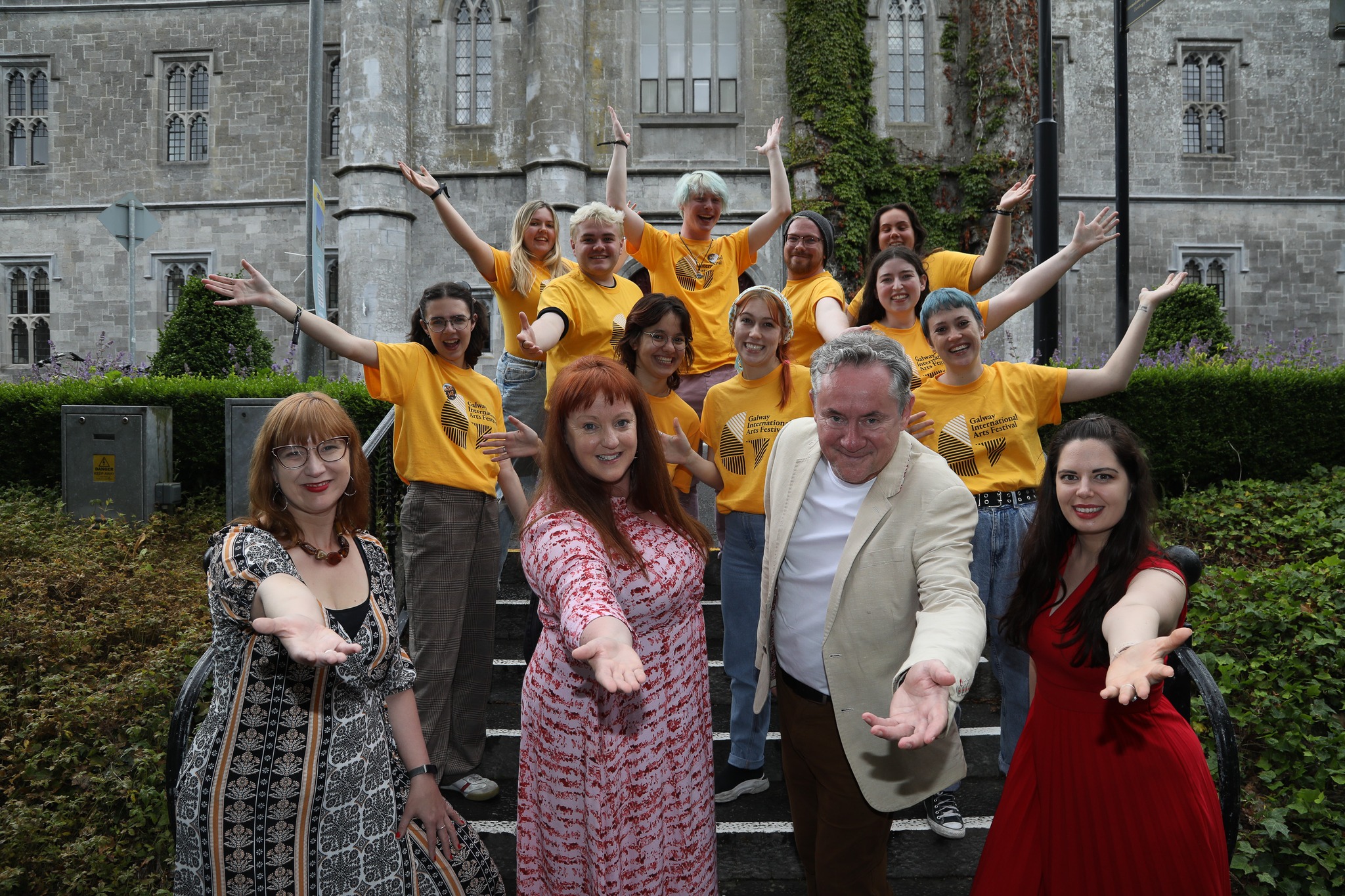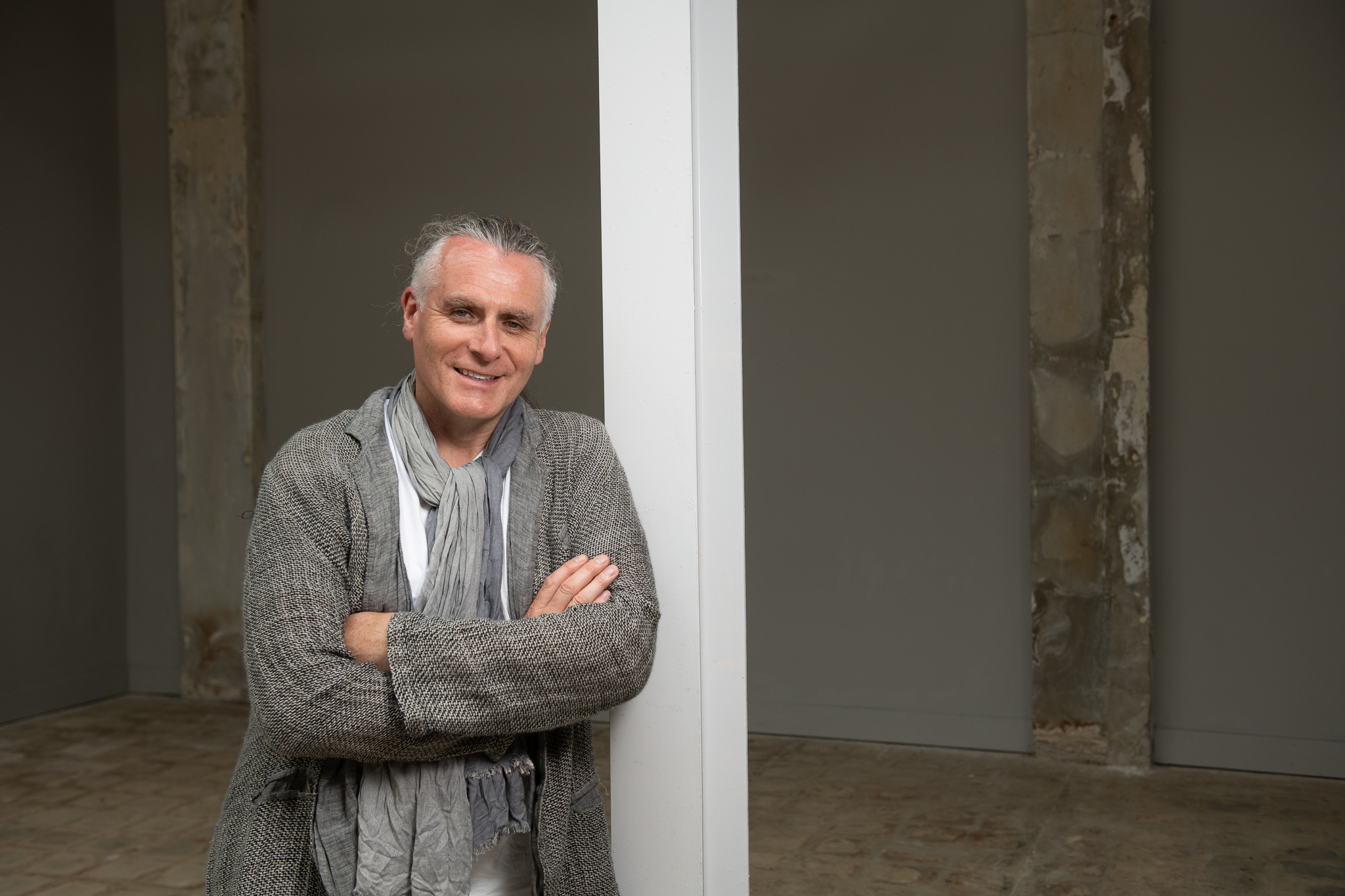
Artistic Director Paul Fahy talks to Cois Coiribe Impact about the challenges of reducing the festival’s carbon footprint, whether conversations sparked from artworks can outweigh their material impact and how the SELECTED internship programme is educating the next generation of arts professionals.
CC: What are some of the changes you’ve made to Galway International Arts Festival to reduce your carbon footprint?
PF: At the moment, we’re laying out all our internal goals and ambitions and looking at things like reducing our energy requirements. We already have a set of targets we want to reach by 2025. We want to gather all of this information, so that we have a clear picture of our impact and what can be done about it. We also want to create awareness amongst our associates and colleagues, so that they can join in the conversation.
Another question we’re asking is: how do you provide a high-standard venue in an empty field like the Fisheries Field – where our biggest venue, The Big Top is held – with all the artists’ requirements? Everything, from a toilet to the stage and lighting draws energy.
It’s not like you can just use a domestic plug to run a gig; you’re using three-phase electricity. You need big, big power, so we are currently looking at possible alternatives to the traditional diesel generator.
Our partners are helping us to achieve our goal of reducing our carbon footprint.
We’re trying to make an impact with everything we do, starting with the programme brochure. The programme brochure is a great archival document, but we’re now only printing a limited number on recycled paper, and any excess goes back into recycling.
Then, at the events themselves: what are people drinking or eating from? At a Big Top gig with 3,500 people, we are looking to eliminate the use of any single-use plastic and we’ve been working with Heineken to provide reusable glasses. When the concert is finished, we gather thousands and thousands of these glasses and ship them off to be cleaned for the next gig, meeting all of the HSE (Health Service Executive) standards.
The GIAF Festival Garden has been running for four years now – a place where people can hang out and buy food and drink. A key aim for GIAF this year was to make this space as sustainable as possible and, so, working with Flogas, we installed a row of solar panels and have been able to power the garden using solar energy.
We’re also considering transport to and around the festival. We have put out advice on how to get to the festival and around the festival in sustainable ways.
We have also had conversations with members of our supply chain, including all our providers and customers. So, it’s not only about the festival organisers; it’s a larger conversation among the community.
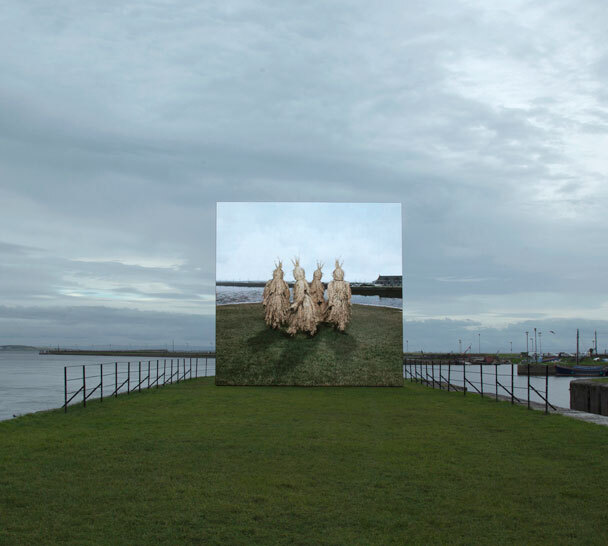
CC: As a team, how do you weigh up the goal of reducing your carbon footprint with the goal of influencing cultural narratives through large-scale, impactful artworks?
PF: We have to accept that we all have a carbon footprint; we just need to look at how to manage it better. We’ve learnt a lot about sustainability through projects like John Gerrard’s Mirror Pavilion, which we’ve been working on for the guts of five years.
Initially, we planned to completely power the Claddagh iteration using green energy from water flowing through Galway – knowing that this water had powered so many mills over the centuries. As you start to investigate how to harness that energy, things get in the way. For instance, putting turbines in the water sounds easy, but you have to consider the impact on sea life etc. There is a huge number of factors to think about. Sometimes people’s goals are more advanced than what technology currently offers. Flogas were able to provide us with the green energy to run the Mirror Pavilion in the Claddagh.
Mirror Pavilion in Connemara was an even more difficult task in terms of sustainability. We were trying to relay a message about our effect on the world around us, while in the middle of one of the most protected environments in the country – the Derrigimlagh Bog. We spent years working through the various challenges that that presented.
Mirror Pavilion required a lot of transport and materials, but it was located on the site where [Italian inventor and engineer] Guglielmo Marconi succeeded in sending the first telegraph across the Atlantic Ocean. The Derrigimlagh Bog was also the site where John Alcock and Arthur Brown crash landed during the first trans-Atlantic flight. So, it was an incredible site in terms of commenting on two huge sources of energy consumption that have changed our lives.
That artwork received global publicity and was recently featured in the 23rd Biennale of Sydney. It’s amazing the conversations that have been triggered by that. As most of us in Galway know, the Claddagh is a great gathering point for young people. I can’t count the number of conversations about Mirror Pavilion I had down there with 20-year-olds, who you would think might be bigger activists than me who were telling me, ‘I never thought about that.’ So, you have to look at the greater good in those conversations, versus the impact of what it took to physically make the work.
We’ve had a similar situation with John Gerrard’s Flare (Oceania) this year – a simulated image of fire and smoke on the ocean. It’s powerful to see it in the working docks.
So, you weigh up all of these things. Is the materiality of the work worth the impact? Yes, is my answer.
ANNEX is also asking critical questions in Entanglement, an artwork which was at the Architecture Biennale in Venice last year. The piece is a sort of circular tower made up of screens displaying words and thermal feedback images of viewers. The group is commenting on the material implications of holding all of this information in the cloud, but it also goes back to the notion of people sitting around the campfire – exchanging ideas and conversations. So, here we are around this other kind of fire, exchanging information. Because it’s so visually spectacular, I think that this work will really generate a lot of great conversations.
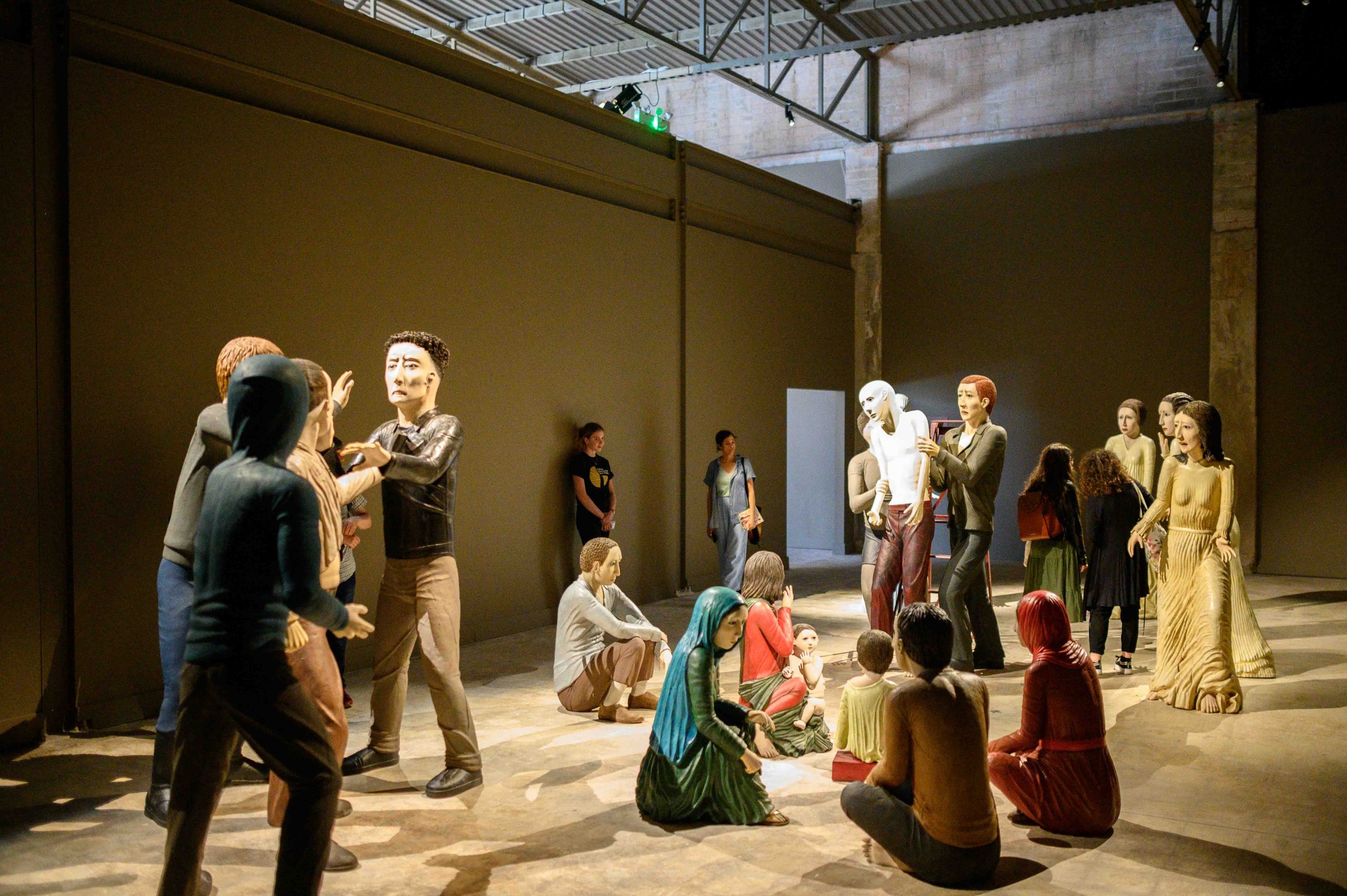
CC: Does curation and set-building also come into that process of weighing up consumption and environmental impact?
PF: We have a history of going into non-art spaces and transforming them into galleries, out of both necessity and desire. With [Brazilian sculptor, painter and printmaker] Ana Maria Pacheco’s exhibition this year, we’ve reimagined the Festival Gallery. All of the materials we’ve used in restructuring the gallery are recycled from previous constructions. And all the timber that Pacheco had used in her larger-than-life sculptures of human figures is also recycled. The stunning, 19-figure piece is a new commission. So, they used trees that were felled from Windsor gardens as part of a thinning process to allow the growth and nurture of other trees. They would have been felled in any case.
With Enda Walsh’s Rooms, a series of installations including this year’s Middle Bedroom, all of the physical materials involved in the series are repurposed or recycled. There aren’t many theatre set specialists in Ireland as it’s a small country. We’re really keen to make everything locally-produced, but oftentimes, you will have to go to Dublin or London, which requires more consumption. We’re lucky that in Galway, we’ve nurtured these teams over the years. So, we have our own workshop here where we build most of our larger sets. We also have a storage space for previous materials which are available for repurposing.
We’ve had a lot of climate discussions during our First Thought Talks, with various ministers of environment and activists speaking. Sustainability is something that we’re very interested in. The climate is changing and we all have a collective responsibility to be more sustainable. If we all don’t do something, we’re in trouble. We can’t bury our heads in the sand. And we haven’t just woken up to this; we’ve been working towards a sustainable transition for a while.
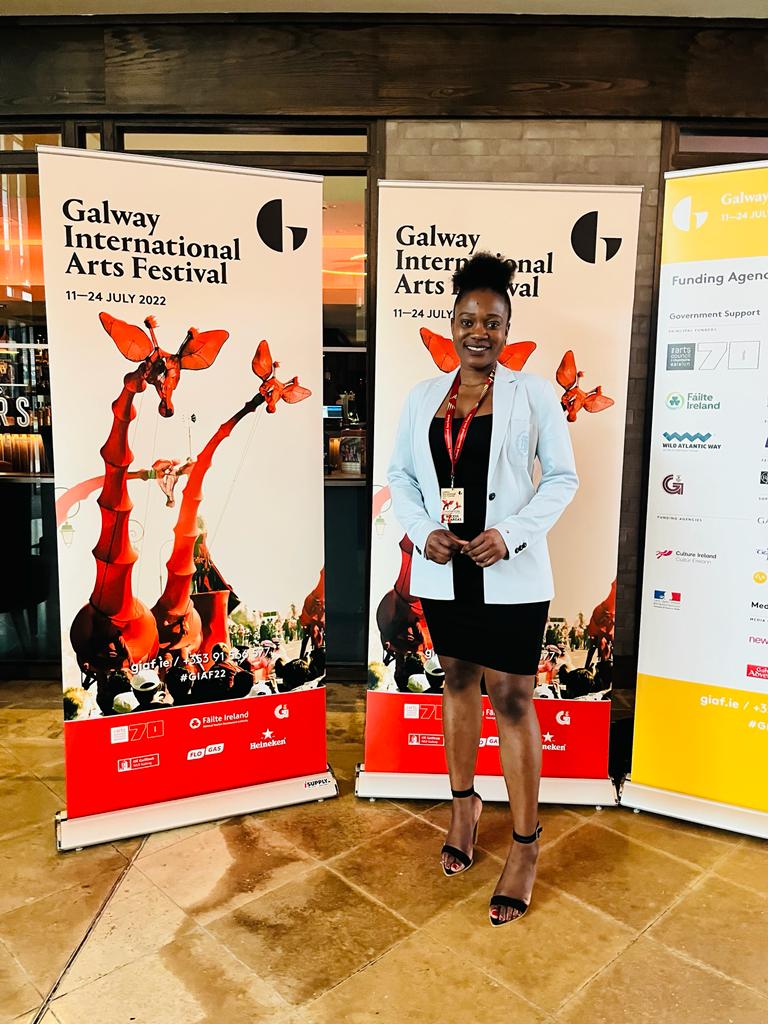
CC: Georgina [Edziwa], you’re a new member of the GIAF team. Can you briefly explain your main goals for the festival, as Sustainability Manager?
GE: My role is all about exploring actions we can put in place to build a strong foundation for our sustainability operating system. The festival has been immensely engaged in sustainability practises in previous years, mainly through its programming structure and various operational initiatives and we’re moving in the right direction.
This year, we hope to reduce our carbon footprint by a substantial percentage – reducing energy consumption and waste, and managing water resources effectively. We’re also working towards powering the Heineken Big Top with renewable energy sources in the coming years. We hope to lead by example and show that sustainability is attainable in the Arts sector; it only requires taking a few steps at a time.
CC: [To Paul] The partnership and, in particular, the SELECTED programme has facilitated NUI Galway students to gain on-the-ground experience with the festival, which contributes to developing a sustainable career. What impact has this programme had on budding artists and curators?
PF: SELECTED was set up because there was nowhere for people to go and train to be an artistic director or chief executive of a festival. We wanted to offer insight to graduates coming out of college who are interested in taking up this kind of career – to offer them a 360° view of what it takes to run a festival – both the glamorous and unglamorous parts. The idea is that after the three weeks, they would either say, ‘Watch out, I want your job,’ or run a mile.
For people starting out in arts careers, the programme allows them to get to know the [industry] and the ways in which people are trying to run the industry more sustainably. We will have those conversations with the SELECTED participants this year. As well as explaining how the festival works, we will be responding to questions like, ‘Why did you make the decision to make this? Is it worth the material requirements?’
It can be a tough life in the artworld; we need to try to make these careers more sustainable in terms of providing opportunities for people to be able to present their work. That’s another aim of ours: to provide that platform for younger [artists and creatives] to get involved in a bigger international festival.
One of the first things we do with the SELECTED team is to talk about the artwork – it’s just fascinating every year to hear the new insights. ‘Why did you do that? Why wouldn’t you look at doing something like this?’ It’s fantastic to be challenged and learn from each other, whether you’re learning from somebody with two PhDs or a student in their twenties who is going to be a great theater maker.
The number of NUI Galway graduates that have worked with the festival, whether through SELECTED or previous programmes, is amazing. [The partnership is also important] in animating the grounds of the university as a cultural stage in the city centre, because Galway is starved of cultural infrastructure. To transform the Bailey Allen Hall, an educational venue, into a performance space for the world-class opera like The First Child [is a brilliant opportunity].
One of the biggest assets that NUI Galway has is the endlessly fascinating [range of knowledge]. There are many interwoven skillsets in this partnership, and the brain power of the university’s lecturers and professors [helps to drive] our First Thought Talks programme. I’ve always felt that Galway has been a city with two things at its core – one is education, primarily through the university; the other is culture through the likes of ourselves, Druid and Macnas. It’s fantastic to have a city that celebrates and expresses itself as a town for learning and culture. When those two pillars of a city come together as a unit, powerful things can happen.
